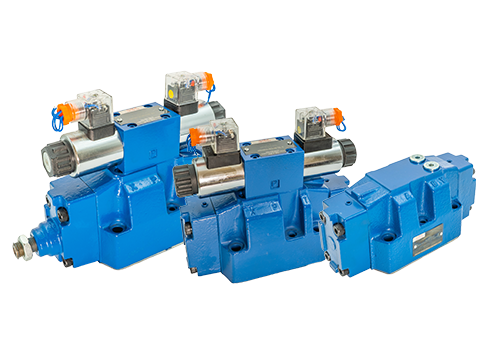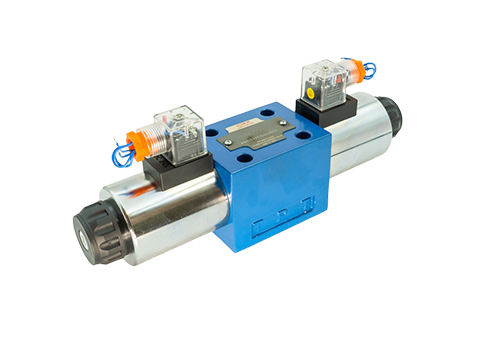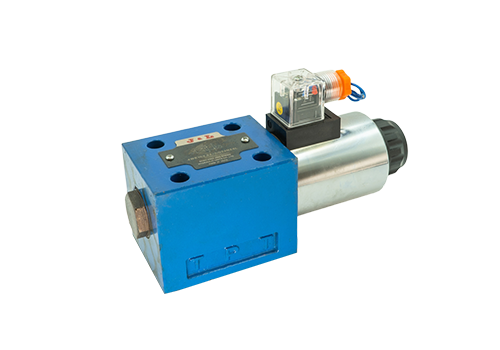
2025-09-08 The characteristics of 4WEH16 electro-hydraulic reversing valve are as follows: Structural features: Plate connection: The connection size complies with DIN24340A standard, is standardized and convenient to install. A variety of performances and additional devices are available: Pilot control solenoid valve: available in wet AC or DC solenoids, and can also be selected with or without manual buttons. There are two types of electrical connections: separate and centralized. Main valve reset method: The main valve uses spring-to-neutral neutralization spring to reset or hydraulic neutralization fluid. Other optional devices: with or without reversing time regulator; with or without main valve stroke regulator or main valve spool terminal position indicator; with or without main valve terminal position switch; prepressure valves can be installed in the main valve; plug-in dampers can be installed; pressure reducing valves can be installed when the working pressure exceeds 25MPa, and there are 19 standard functions in total. Working principle features: solenoid valve pilot control: WEH type electro-hydraulic reversing valve is a slide valve type reversing valve that uses solenoid valve as pilot control, used for
Read More 
2025-09-05 4WE10 solenoid reversing valve has the characteristics of high reliability, multiple control methods, flexible electrical connections, modular design, a wide range of application fields, strong pressure resistance, large flow rate, blocked external leakage and easy control of internal leakage. The specific details are as follows: High reliability: High quality materials and precision manufacturing processes are used to ensure that the valve can still work reliably in harsh environments such as high pressure and high temperature. For example, its electromagnetic iron can be easily rotated and replaced, which is convenient to maintain, and the electromagnetic coil is designed to comply with international standards and supports long-term stable operation. Various control methods: support electromagnetic drive and manual emergency switching to meet the operating needs in different scenarios. In the event of power failure or emergency, the manual switching function ensures that the equipment continues to operate and improves system safety. Flexible electrical connection: Provides multiple electrical connection methods and is adapted to different control systems. At the same time, contactless position detection function can be optionally installed to achieve precise control and improve automation level. Modular design: structure
Read More 
2025-09-03 4WE10 single-head solenoid reversing valve is a common hydraulic control element. It is widely used in industrial hydraulic systems. It is used to control the flow direction of hydraulic oil and realize the start, stop, reversal and speed adjustment of actuators (such as hydraulic cylinders and hydraulic motors). The following are its detailed usage methods and precautions: 1. Basic structure and working principle Structural composition: Valve body: usually made of cast iron or steel, with multiple oil passages inside. Electromagnets: divided into two types: AC (AC) or DC (DC), and the valve core is controlled by power-on/off. Valve spool: It can slide in the valve body under the action of a solenoid to change the oil circuit connection method. Spring: Used to reset the valve core (restore the initial position when power is off). Seal: Prevent hydraulic oil leakage. Working principle: Power off state: The spring pushes the valve core to its initial position, hydraulic oil flows from the oil inlet (P) to the oil return port (T), and the actuator stops or returns. Power-on state: Solenoid generates magnetic force to attract the valve core, change
Read More 
2025-08-27 The superimposed relief valve is a component that realizes pressure control of the hydraulic system through superimposed installation. It has the advantages of compact structure, flexible installation and easy maintenance. It is widely used in hydraulic systems such as machine tools, injection molding machines, and engineering machinery. In order to ensure its stable performance, extend its service life and avoid safety hazards, the following key matters should be paid attention to when using: 1. Installation and connection precautions. Installation direction and cleanliness are installed vertically: The superimposed relief valve usually needs to be installed vertically (the axis of the valve core is perpendicular to the ground) to avoid abnormal movement of the internal spring due to gravity deviation. If you need to install horizontally, you need to confirm that the product instructions allow it and install an anti-vibration bracket. Cleanliness requirements: Before installation, the hydraulic system must be thoroughly cleaned to avoid impurities (such as metal chips, seal debris) entering the valve body, causing the valve core to stagnate or seal failure. It is recommended to use a special cleaning agent to flush the pipeline and install a filter (filtration accuracy ≥10μm). Overlay order and direction overlay order:
Read More 
2025-08-25 The superimposed hydraulic control check valve is an important control element in the hydraulic system. It combines the one-way conduction characteristics of the check valve and the reverse opening capability of the hydraulic control function, and simplifies installation and integration through the superimposed design. Its core role can be summarized into the following five aspects, detailed descriptions based on specific application scenarios: 1. Basic functions: One-way conduction and reverse controllable opening forward flow freely. When the oil flows from the valve inlet (P) to the oil outlet (A), the valve core automatically opens under the action of oil pressure, the oil can pass without hinderment, and the pressure loss is extremely small (usually ≤0.3MPa). Application scenario: During the extension stroke of the hydraulic cylinder, oil flows from the pump to the rod-free cavity of the hydraulic cylinder. The superimposed hydraulic control check valve allows the oil to flow freely and drives the piston to move. Reverse flow hydraulic control is turned on. When oil is required to flow back from the oil outlet (A) back to the oil inlet (P), the control pressure oil must be passed through the control port (K). After the control pressure overcomes the spring force, the valve core
Read More 
2025-08-22 4WEH16 electro-hydraulic reversing valve is a key control element widely used in hydraulic systems. It is used to switch the flow direction of hydraulic oil, thereby controlling the movement direction of the actuators (such as hydraulic cylinders, hydraulic motors). Its use needs to be combined with the characteristics of the hydraulic system, electrical control logic and environmental conditions. The following are detailed precautions for use, covering five major aspects: installation, commissioning, operation, maintenance and fault handling: 1. Check and prepare the environmental adaptability confirmation temperature range: Ensure that the working environment temperature is between -20℃ and +80℃ (if it exceeds the high-temperature or low-temperature resistant model, such as adding a heater or cooling device). Humidity control: Avoid long-term use in humid environments with humidity >85%, and prevent short circuit or corrosion of electrical components (such as solenoid coils). Dust protection requirements: The installation position should be kept away from dust sources, or a dust cover should be installed (protection level is recommended to be IP65 or above) to prevent valve core from being stuck or seal wear. Hydraulic system
Read More 




